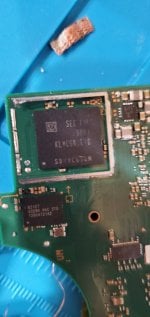Make sure to add solder mask on the left and right sides of it. I find that 1 joint is too flimsy.
Also, not many people know this but add solder mask on the solder joints as well. If your solder is a little bit too much, it could touch the nand shield and shorting DAT0 pin to ground. Better yet, add kapton take on the insides of the nand shield.
I might had similar problem but not due to excess of solder. I think my problem could be because I soldered the enamel wire in the wrong direction, and then, to route the wire to the correct direction I had to bend it a bit inside the NAND frame! An maybe the wire did unbend itself a bit and touched the NAND frame. Then, I had to disassemble the console again, and make sure that the wire wouldn't touch the frame again (in case that was the problem) and also reflowed the anchor point and tried to give the adapter a tighter push underneath the NAND chip to ensure better contact with DAT0 line.
After that, things have been running smoothly!








